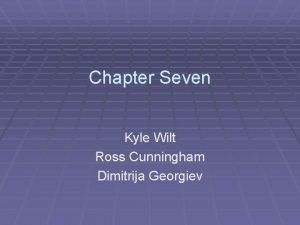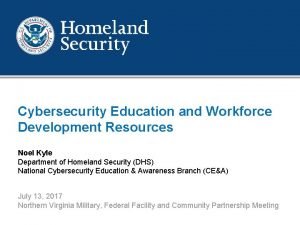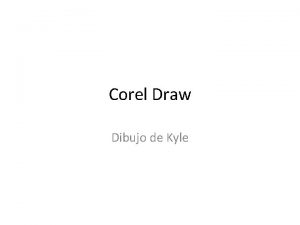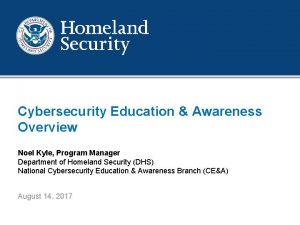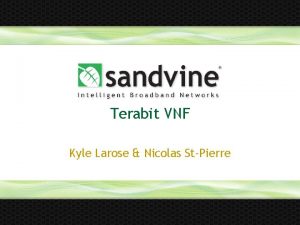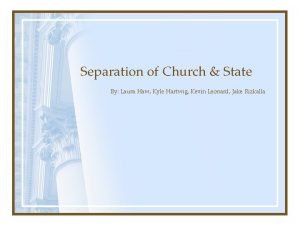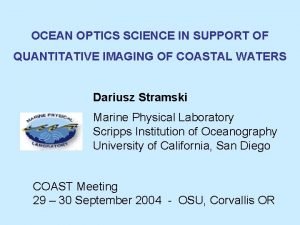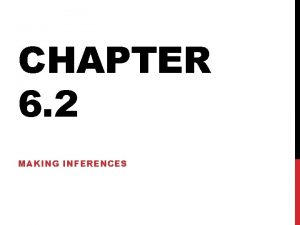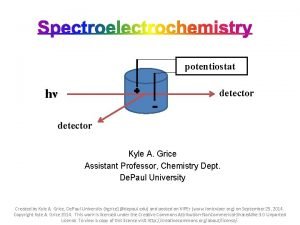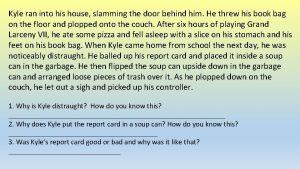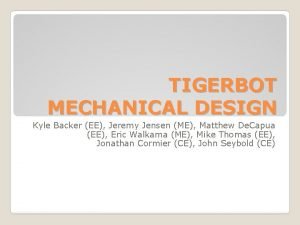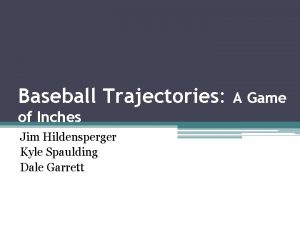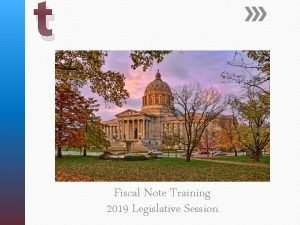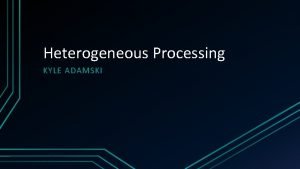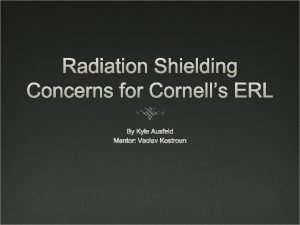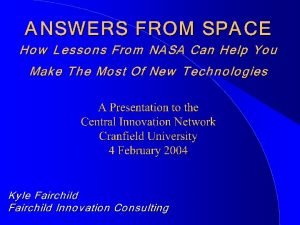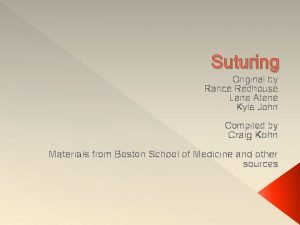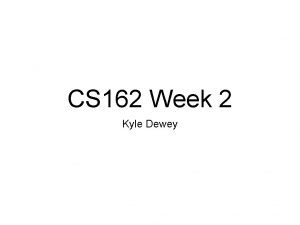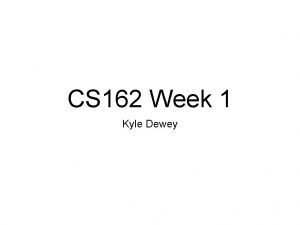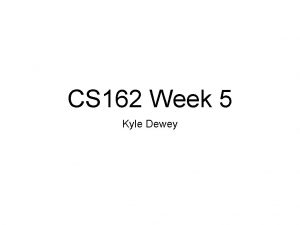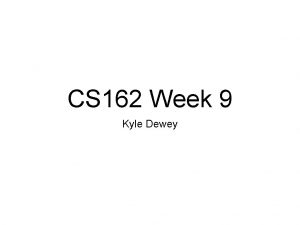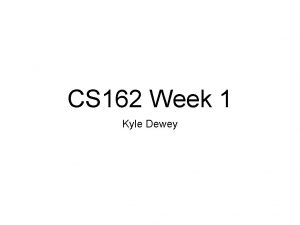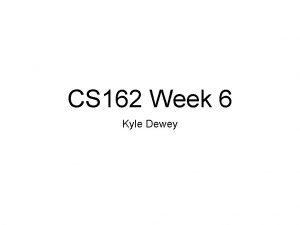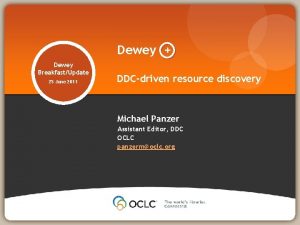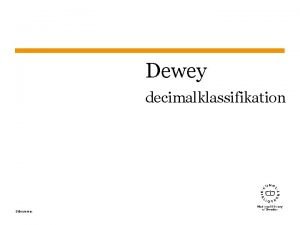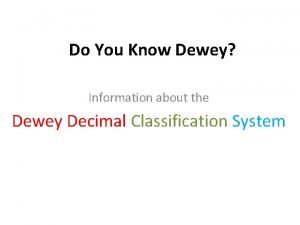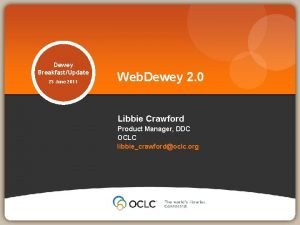Discussion Week 5 TA Kyle Dewey Overview HW






































- Slides: 38

Discussion Week 5 TA: Kyle Dewey

Overview • HW 3. 10 and 6. 2 review • Binary formats • System call execution in NACHOS • Memory management in NACHOS • I/O in NACHOS

Homework 3. 10 • “Identify the values of pid at lines A, B, C, and D. Assume that the actual pids of the parent and child are 2600 and 2603, respectively. ”

Homework 6. 2 • The Cigarette-Smokers Problem Match Smoker Paper Smoker Table (holds two of three items) Agent Tobacco Smoker

Problem Specifics • Agent places two items • Smoker with remaining item grabs the two and smokes • The process repeats

Java Implementation

Binary Formats

NOFF • NACHOS Object File Format Magic Number (0 x. BADFAD) Code (Text) Initialized Data (Data) Uninitialized Data (BSS)

Why Bother? • CPU sees only a stream of instructions • All gets loaded into memory anyway

Advantage • Tells OS roughly how portions will be used • Optimizations possible • Share (reentrant) code and constant data • Prevent execution of non-code regions

System Calls Revisited

System Call Execution read() User Space read() read. From. Disk( ) Kernel Space

User -> Kernel • Problem: kernel space and user space are enforced by hardware • Hardware must be informed of jump

Solution? • Instruction to specify the level • By necessity, it is privileged • Need kernel space to tell the system we’re in kernel space - catch 22

Existing Machinery • Interrupts are serviced by the kernel • Generated from other devices, often I/O • Preempt all else and enter the kernel • The routines that service interrupts are called “interrupt service routines” - ISRs

Interrupts Memory Hard Drive Int 1 ISR 1 CPU ISR 2 ISR 3

Using Interrupts • Trigger a “software interrupt” • Kernel mode entered synchronously • Parameters can be passed in registers, in a specific memory location, etc. • Note that the actual mechanism and lingo is hardware dependent

MIPS System Calls • MIPS has the “syscall” instruction • Processor throws a system call exception, triggering the OS’ system call service routine • By convention, the syscall ID is in $v 0, and arguments are passed in $a 0 and $a 1

MIPS System Calls • Assume we want the system call with ID 5 • This call takes no arguments addi $v 0, $zero, 5 syscall CPU Syscall ISR Syscall 5 Handler

• code/userprog/ exception. cc • code/userprog/ syscall. h • code/test/star t. s

Memory Management

Project #2 Memory • Physical = virtual (until Project #3) • Must using paging • Need to allocate and free pages as requested

NACHOS Memory • Does not have much • 128 byte pages • 32 pages total • 8 pages for each process’ stack + data + code • Simple bitmap is sufficient to record what is and is not used

Contiguous Memory • Since physical = virtual, served memory requests must be contiguous • I. e. if a process requests 5 pages, they must be contiguous • *Could* do compaction, but this is a terrible idea

Fork() Example Memory by page Used - P 1 Free Used - P 3 Free P 1 fork()s P 3 Free Used - P 2 Free

Exit() Example Memory by page Used - P 1 Used - P 3 Free P 2 exit()s Free Used - P 2 Free

Getting Pages • Memory is available through: • machine->main. Memory • Merely array of 1 byte characters • Need to split into pages on your own

Memory and Concurrency • Multiple processes may request pages at the same time • Only one may get any given page • Synchronization primitives from Project #1 will have to be used • Make sure they work correctly!

I/O Syscalls

NACHOS Disk • Do not need to worry about this until Project 3 • I/O syscalls for Project 2 utilize Linux’s existing syscalls for file I/O directly

I/O Syscalls • Actually implement Read() and Write(), NOT read. At() and write. At() • read. At() and write. At()’s provided implementations are sufficient to implement Read() and Write()

Files and Concurrency • Process A prints “Hello world!” • Process B prints “Goodbye cruel world!” Hello wo. Goodbye crld! ruel world!

Files and Concurrency • Determining what needs to be locked may be difficult • May have separate things that need locking • May need multiple locks for distinct resources • Concurrent reads are OK, but not concurrent writes

Open File Semantics • Semantics of Fork() are that child processes inherit open files • Read() and Write() can only manipulate open files • If a process will not close its files upon Exit(), then the OS must do so

Open Files • Which files are opened must be recorded in the PCB • This allows for all aforementioned behaviors • Also allows for an offset for subsequent Read() and Write() requests

Console • Read() and Write() may also manipulate the console • Console is not opened or closed • Constants specifying console usage are in syscall. h

Caveats • The given code is really getting buggy • Provided code is also getting really ugly

How-To Implement • Project #2 has a step-by-step implementation guide at http: //www. cs. ucsb. edu/~cs 170/projects /homework_2 guide. html • Please read carefully
 Week by week plans for documenting children's development
Week by week plans for documenting children's development Simple distillation introduction
Simple distillation introduction Kyle clark fsu
Kyle clark fsu Kyle wilt
Kyle wilt Kyle fitzgerald death
Kyle fitzgerald death Noel kyle
Noel kyle Kyle babick
Kyle babick Kyle dibujo
Kyle dibujo Legendary cars
Legendary cars Noel kyle
Noel kyle Soapier
Soapier Kyle larose
Kyle larose Bourdon-wiersma test
Bourdon-wiersma test Laura haw
Laura haw Scott kyle
Scott kyle Kyle stramski
Kyle stramski What is an inference
What is an inference Why does kyle put the report card in a soup can
Why does kyle put the report card in a soup can Factoring flow chart
Factoring flow chart Kyle grice
Kyle grice Kyle corbitt
Kyle corbitt Why is kyle distraught?
Why is kyle distraught? Kyle backer
Kyle backer Kyle spaulding
Kyle spaulding Kyle adamski
Kyle adamski Kyle cormack
Kyle cormack Log file switch checkpoint incomplete
Log file switch checkpoint incomplete Kyle rieman
Kyle rieman Kyle gaines
Kyle gaines Kyle adamski
Kyle adamski Kyle ausfeld
Kyle ausfeld Kyle etzkorn md
Kyle etzkorn md Kyle rader
Kyle rader Kyle wilson elementary
Kyle wilson elementary Https://a-z-animals.com/animals/
Https://a-z-animals.com/animals/ Kyle fat
Kyle fat Kyle fairchild
Kyle fairchild Kyle dickard
Kyle dickard Uninterrupted suture
Uninterrupted suture



